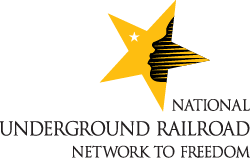
What is the Underground Railroad?
The Underground Railroad was a loosely organized system for helping Freedom Seekers (formerly enslaved people) from the southern states reach freedom in the North or Canada in the years before the Civil War.
How did it get its name?
The legend is that in 1831, a Freedom Seeker named Tice Davids ran away from a Kentucky plantation. His master followed him but lost track him with Tice dived into the Ohio River and swam across to Ripley, Ohio. Returning home empty handed, Tice’s owner told everyone that his enslaved person “must have disappeared on an underground road.”
Steam railroads were a new and exciting way to travel in the 1830s, so historians believe that’s how the term Underground Railroad came into use. This terminology extended to those who helped freedom seekers, including “station agents” for those who provided shelter in their homes or businesses, and “conductors” for those brave men and women who helped transport these brave individuals to freedom.
How was James Jordan involved in the Underground Railroad?
James C. Jordan was born in 1813 in what is now West Virginia, in a community where slavery was ingrained in society and culture. Jordan was expected to assist neighbors in their hunt for escaped slaves, and these experiences developed his abolitionist beliefs and zeal.
During the antebellum period, the Jordan House was a stop on the Underground Railroad, and Jordan was regarded as the “Chief Conductor” for Polk County.
The History of Polk County, published in 1880, says “Jordan has been a life-long enemy of slavery; his devotion to the political life as a staunch and stalwart Republican is the outgrowth of deep-seated conviction; it is among the pleasant things to remember, that under his protecting roof John Brown and his associates, with more than a score of recently liberated slaves, have offered their prayers and sung their first jubilee hymns on their way to Canada….”
In fact, radical abolitionist John Brown stayed at the Jordan House at least twice, the last time in 1859 when he was leading a group of 12 formerly enslaved people he and his men had recently liberated in Missouri to freedom in Canada.
How many Freedom Seekers reached freedom on the Underground Railroad?
No one knows for sure, but historians estimate that 1000 per year made the attempt. Most who tried did not have the benefit of someone like John Brown or Harriet Tubman. The bravery of these men, women and children to take this journey can’t be overlooked.
Learn more about the Underground Railroad and James Jordan by visiting the Jordan House.
